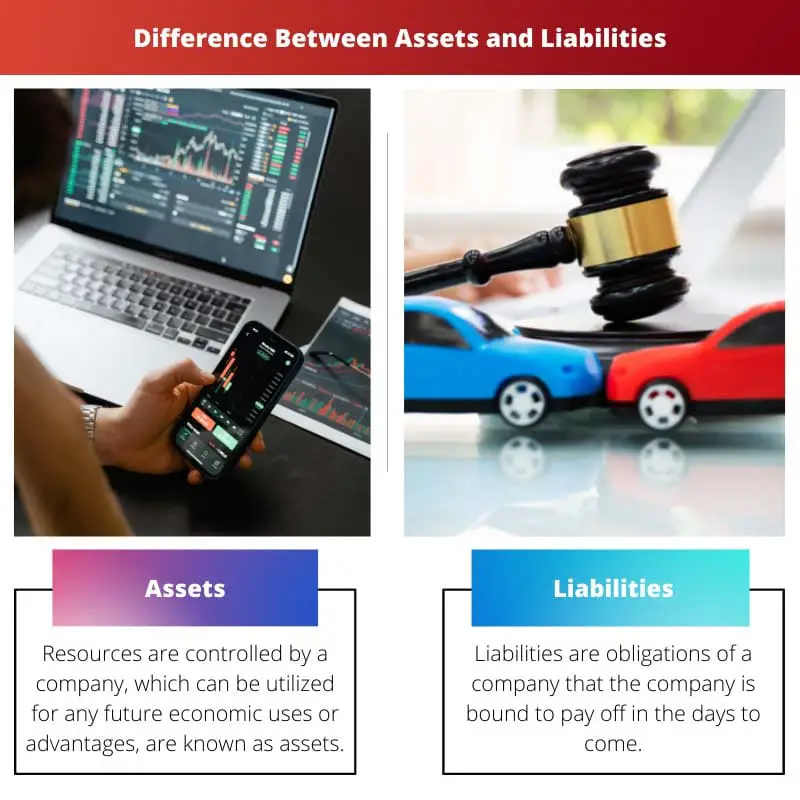Assets are resources owned by an individual or entity that hold economic value, such as cash, investments, or property. They contribute to generating income or providing future benefits. In contrast, liabilities are obligations or debts owed to others, including loans, mortgages, or unpaid bills, which require future repayment or fulfillment.
Key Takeaways
- Assets are resources owned by a company that has value and can be converted into cash.
- Liabilities are obligations owed by a company to other parties, such as suppliers, lenders, and employees.
- Assets generate revenue and profits for the company, while liabilities represent business costs.
Assets vs Liabilities
An asset has value and is owned by a business or individual, such as cash, investments, property, or inventory that generates income. A liability is a financial obligation that a business or individual owes to someone else, such as a loan, accounts payable, or taxes.

Examples:
- Assets: Accounts Receivable, Machinery, Cash, Furniture.
- Liability: Accounts Payable, Bank Overdraft, Outstanding Expenses.
Contrary to assets, liabilities are non-depreciable. Thus, the primary difference between assets and liabilities is that the former is depreciable and the latter is non-depreciable.
Comparison Table
| Feature | Assets | Liabilities |
|---|---|---|
| Definition | Resources owned by an individual or business that have economic value. | Financial obligations owed by an individual or business to others. |
| Nature | Benefits: Assets are expected to generate future economic benefits, either through income or by being sold. | Obligations: Liabilities represent claims against assets, requiring future payments or fulfillment of other obligations. |
| Classification | Can be categorized as: – Tangible: Physically touch and exist, like cash, inventory, equipment. – Intangible: Non-physical assets, like copyrights, patents, brand value. – Current: Expected to be used or converted to cash within a year, like cash, accounts receivable, inventory. – Non-current: Not expected to be used or converted to cash within a year, like land, buildings, equipment. | Can be categorized as: – Current: Debts due within a year, like accounts payable, accrued expenses, short-term loans. – Non-current: Debts due after a year, like long-term loans, mortgages, bonds. |
| Impact on Financial Statements | Increase assets by debiting them. Decrease assets by crediting them. | Increase liabilities by crediting them. Decrease liabilities by debiting them. |
| Impact on Net Worth | Increase net worth by increasing assets or decreasing liabilities. | Decrease net worth by increasing liabilities or decreasing assets. |
| Financial Goal | Maximize assets while minimizing liabilities to achieve a strong financial position. | Manage and pay down liabilities responsibly. |
What are Assets?
Assets represent resources owned by individuals, businesses, or entities that hold economic value and contribute to their net worth. These resources can be tangible or intangible and are acquired or created with the expectation of generating future benefits. Understanding the nature and classification of assets is essential for effective financial management.
Types of Assets
- Tangible Assets: These are physical assets that can be touched or felt. Examples include real estate, machinery, equipment, inventory, and vehicles. Tangible assets play a critical role in the operations of businesses and can be depreciated over time to reflect their diminishing value.
- Intangible Assets: Intangible assets lack physical substance but possess value due to legal rights or intellectual property. This category includes patents, trademarks, copyrights, goodwill, and brand recognition. Intangible assets are vital for competitive advantage and long-term success, requiring careful valuation and management.
- Financial Assets: Financial assets represent ownership of a contractual claim to future cash flows or financial benefits. They can be categorized into two main types:
- Equity Securities: These represent ownership stakes in companies, such as stocks or equity mutual funds. Equity securities provide ownership rights and the potential for capital appreciation and dividends.
- Debt Securities: Debt securities represent loans provided to governments, corporations, or other entities in exchange for periodic interest payments and the repayment of principal. Examples include bonds, treasury bills, and corporate bonds.
- Current Assets: Current assets are resources expected to be converted into cash or consumed within one year or an operating cycle. They include cash and cash equivalents, accounts receivable, inventory, and short-term investments. Current assets play a crucial role in liquidity management and meeting short-term obligations.
- Non-Current Assets: Non-current assets are resources expected to provide economic benefits beyond one year. Examples include long-term investments, property, plant, and equipment, intangible assets, and goodwill. Non-current assets contribute to long-term growth and sustainability.
Importance of Assets
- Wealth Creation: Accumulating and managing assets is essential for building personal wealth and achieving financial goals.
- Risk Management: Diversifying asset holdings can help mitigate risk and protect against economic uncertainties.
- Investment Opportunities: Assets provide opportunities for investment, income generation, and capital appreciation.
- Financial Stability: Maintaining a healthy balance of assets ensures financial stability, resilience, and the ability to weather economic challenges.

What are Liabilities?
Liabilities represent financial obligations or debts owed by individuals, businesses, or entities to external parties. They arise from past transactions or events and require future sacrifices of economic benefits. Understanding the nature and classification of liabilities is essential for assessing financial health and managing obligations effectively.
Types of Liabilities
- Current Liabilities: Current liabilities are obligations expected to be settled within one year or an operating cycle, whichever is longer. They include:
- Accounts Payable: Amounts owed to suppliers or vendors for goods or services purchased on credit.
- Short-Term Loans: Borrowings with repayment due within the next year, such as lines of credit or short-term notes payable.
- Accrued Expenses: Expenses incurred but not yet paid, such as salaries, utilities, or taxes.
- Current Portion of Long-Term Debt: The portion of long-term debt expected to be repaid within the next year.
- Non-Current Liabilities: Non-current liabilities are obligations not due for settlement within the next year. They include:
- Long-Term Loans: Borrowings with repayment terms extending beyond one year, such as mortgages or long-term bonds.
- Deferred Tax Liabilities: Taxes that will be payable in future periods due to temporary differences in accounting treatment.
- Pension Obligations: Commitments to provide retirement benefits to employees in the future.
- Lease Obligations: Payments due under long-term lease agreements for equipment, property, or vehicles.
- Contingent Liabilities: Contingent liabilities are potential obligations that depend on the occurrence of uncertain future events. They may arise from legal claims, warranties, guarantees, or pending lawsuits. While contingent liabilities may not require immediate settlement, they can impact financial reporting and disclosure requirements.
- Financial Liabilities: Financial liabilities represent contractual obligations to transfer financial assets or settle with another party. They include:
- Borrowings: Funds borrowed from lenders, including loans, bonds, or commercial paper.
- Derivative Liabilities: Obligations arising from derivative financial instruments, such as futures contracts, options, or swaps.
- Trade Payables: Amounts owed to suppliers or creditors for goods or services purchased on credit.
- Financial Leases: Obligations under lease agreements that effectively transfer substantially all the risks and rewards of ownership to the lessee.
Importance of Liabilities
- Capital Structure: Liabilities contribute to the capital structure of an entity, alongside equity, influencing its financial risk and leverage.
- Funding Operations: Borrowings and credit facilities provide funds for business operations, expansion, or investment opportunities.
- Financial Reporting: Accurate reporting and disclosure of liabilities are essential for transparency, compliance, and investor confidence.
- Risk Management: Effective management of liabilities involves assessing and mitigating risks associated with debt levels, interest rates, and repayment obligations.

Main Differences Between Assets and Liabilities
- Ownership:
- Assets are resources owned by an individual, business, or entity, representing value and contributing to net worth.
- Liabilities, on the other hand, are financial obligations or debts owed by the same entities to external parties.
- Nature and Purpose:
- Assets are acquired or created with the expectation of generating future economic benefits, such as income, capital appreciation, or utility.
- Liabilities arise from past transactions or events and represent commitments to transfer economic benefits in the future, involving repayment with interest.
- Classification:
- Assets can be classified into various categories based on their characteristics, including tangible, intangible, financial, current, and non-current assets.
- Liabilities are categorized based on their timing of settlement, such as current liabilities (due within one year) and non-current liabilities (due beyond one year), as well as contingent liabilities and financial liabilities.
- Role in Financial Health:
- Assets are essential for building wealth, managing risk, and achieving financial goals, contributing to financial stability and long-term prosperity.
- Liabilities, while providing funding and capital for operations or investments, also pose financial risks and obligations that require careful management to avoid excessive debt burdens and maintain solvency.
- Impact on Net Worth:
- Assets increase net worth when their total value exceeds liabilities, resulting in a positive net worth and financial strength.
- Liabilities decrease net worth, as they represent claims against assets and reduce the overall value available to the entity or individual.


I found this post incredibly enlightening! It really breaks down the distinction between assets and liabilities in a clear and concise manner.
Yes, I appreciate the comparison table presented here, it makes it much easier to understand the contrasting nature of assets and liabilities.
This post raises some interesting points on the classification and valuation of assets and liabilities, shedding light on fundamental accounting principles.
Agreed, Kelly. Understanding the fundamentals of accounting is essential for any individual or business interacting with financial matters.
Definitely, Sophie. Proper knowledge of asset and liability classification can prevent major accounting mishaps down the line.
I found this post quite humorous, presenting dry financial topics in an engaging and comprehensive manner is no easy feat!
Indeed, Fred! The ability to make finance entertaining and understandable is commendable.
I appreciate the practical examples provided, they really drive the points home and make the concepts easier to understand.
Absolutely, translating theoretical knowledge to real-world applications through examples is very effective in learning.
While the post provides a great understanding of assets and liabilities, some of the language used might be too technical for beginners in finance.
That’s true, Edwards. Breaking down complex jargon can go a long way in making financial concepts more approachable.
I can see your point, Isaac. Perhaps simplifying the terminology a bit can make it more accessible to a wider audience.
This post does an excellent job of emphasizing the significance of assets in supporting business operations and growth.
Absolutely, Lucy. The strategic management of assets is essential for ensuring a company’s financial stability and future growth.
I couldn’t agree more, Lucy. Assets play a pivotal role in driving a company’s success and expansion.
I have to disagree with some parts of this post. While assets are essential, I believe that liabilities are equally important in understanding a company’s financial health.
I see where you’re coming from, Jackson, but the primary focus of this post is to distinguish the characteristics of assets and liabilities rather than downplaying their respective importance.
I understand your perspective, Jackson. The management and monitoring of liabilities are indeed crucial for a sustainable business operation.
I found the section on risk assessment particularly insightful, as it emphasizes the importance of evaluating both assets and liabilities in terms of potential financial impact.
Absolutely, Chloe. Recognizing and managing financial risks is a key aspect of maintaining a healthy financial standing.
An outstanding piece, providing a comprehensive understanding of assets and liabilities. Kudos to the author for making finance topics engaging and approachable!
I completely agree, Gmitchell. The post manages to demystify complex financial concepts with finesse.
This comprehensive post provides a detailed explanation of assets and liabilities, making it very informative and helpful for those looking to understand the topic better.
Absolutely, the examples provided also make it easier to grasp the differences between assets and liabilities.
I agree, the post does a great job of breaking down complex financial concepts into easily understandable terms.